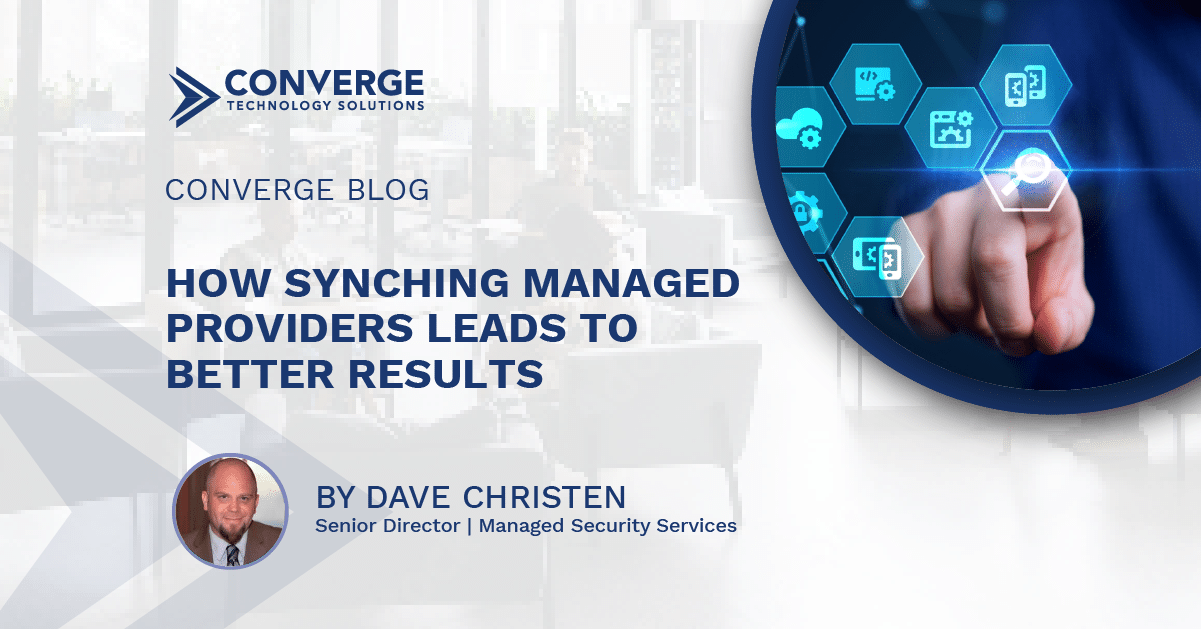If you work with third-party IT and cybersecurity service providers, you already know how they can help you hurdle the challenges and costs of sourcing, retaining, and training in-house teams. The ease and efficiency delivered by managed service providers (MSPs) and managed security service providers (MSSPs) have more organizations relying on these partners to help smooth IT administration and safeguard critical assets, users, and brand reputation.
MSPs focus on ensuring the operation and performance of IT systems. MSSPs focus on cybersecurity. Because these require distinctly different skills and capabilities, it’s a common practice for businesses to use two separate firms.
But that decision can leave some benefits unclaimed.
Net the full benefits of your MSP and MSSP
Just like matching tire treads on your car make for a smoother, safer ride, there are several compelling reasons to have your IT and cybersecurity services delivered by a unified team:
- Seamless integration of services
- Faster response times
- Proactive risk management
- Simplified vendor management
- Cost savings
Seamless integration elevates performance
One significant advantage to working with a combined team for managed security and managed services is seamless integration. Separate providers increase the risk of miscommunication, incompatible tools, and conflicting priorities. The result can be inefficiencies, downtime, and undetected vulnerabilities directly impacting your business.
You are assured of the best possible outcomes when your MSP and MSS providers work together. A shared understanding of your organization’s IT infrastructure, goals, and requirements allows the team to coordinate their efforts, working together to deliver uninterrupted IT operations and secure systems. This integration creates a single source of truth to apply to any engagements your organization undertakes.
Consider incident response. Time and accuracy are invaluable when your organization is dealing with an incident. MSP and MSS teams must have immediate access to information, such as an up-to-date list of high-value assets. When the MSP and MSS teams are cooperative and cohesive, gaining the IR resources needed for a timely, effective response is simpler and faster.
Faster response
Reducing the mean time to respond (MTTR) to issues directly correlates to the impact on your organization. Separate MSP and MSS providers can delay communication and add unnecessary complexities. When a security incident occurs, your MSS provider will likely need to coordinate with your MSP to identify the root cause of the problem and develop a solution. Delays in this process can lead to needless downtime or damage your organization’s reputation.
Working with the same team for both MSS and MSP services typically results in quicker response times and mean time to resolve (MTTR). Tightly integrated MSP and MSS providers working together in real time can quickly identify and respond to issues as they arise. This can significantly reduce the impact of security incidents, minimize downtime, and help your organization maintain productivity and reputation. These service-level agreements (SLAs) are also easier to manage.
Boosted proactive approach
A single team for managed services and managed security services adds the additional benefit of proactive risk management. MSPs ensure the availability and performance of your IT infrastructure while MSS providers identify and mitigate security risks. When these two services are linked at their core, you benefit from a comprehensive risk-management approach that strategically combines availability and security.
Consolidated MSP and MSS providers working together are quicker to identify and communicate about potential security risks before they become problems. This collective team can provide regular security assessments, implement best practices for security and compliance, and keep your systems updated with the latest security patches and updates. A proactive approach to risk management can significantly reduce the likelihood of security incidents and help your organization avoid interruptions and data breaches—two items that should be at the top of every organization’s IT security wish list.
Simplified vendor management
Separate providers for these services mean managing separate vendor relationships, which can be time-consuming and complicated. You will also likely need to negotiate separate contracts, manage separate billing processes, and coordinate between the two providers.
Working with the same team for both services simplifies vendor management. You only need to manage one vendor relationship, typically negotiate one contract, and coordinate with one provider. The administrative burden on your organization is significantly reduced.
Something as simple as reducing the number of status calls or reports needed can save smaller IT teams from being overwhelmed. This combined approach lets you control vendor access quickly, with just one team holistically monitoring and remediating potential insider threats.
Converge assigns each client a client relationship manager who supports the relationship through the life of the engagement. Your client relationship manager keeps your organization’s vision aligned with the service provided and reduces administrative overhead so you can focus on your core business objectives.
Increased cost savings
You can pay more in vendor management fees, licensing fees, and other administrative costs when you work with separate service providers. You may be missing out on additional cost savings possible with an integrated MSP and MSS approach.
Working with a single team provides economies of scale and lower administrative costs. Negotiating better pricing for bundled services is possible and helps your organization reduce its overall IT costs without impacting service quality.
Other considerations
While the benefits above are impactful, there are some situations when it is more appropriate to use separate providers.
Organizations with unique IT needs requiring specialized expertise may find it more beneficial to use separate providers offering the specific skills needed, such as legacy infrastructure. Businesses that must adhere to strict regulatory or compliance requirements may want to work with vendors specializing in meeting those specific requirements.
What to look for in a unified provider
When combining your MSS and MSP teams, your provider must have a strong delivery track record for both services. This expertise and a demonstrated ability to develop a deep understanding of your IT infrastructure and security needs should be essential for your selected provider. The right provider is your ally, helping you ensure that your organization is well-protected against security threats and maintains high IT service quality.
If you’re ready to reap the benefits of integrated service and faster response while saving money, consider combining your MSP and MSS with Converge. We have the experience and reputation to help your organization maximize efficiencies and results.





